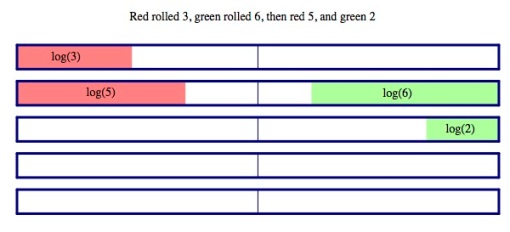I was inspired by a similar game that Steve Willoughby or maybe SRA Real Math contained about fractions. If anyone can track down a link to that, let me know!
This game is played on a board with some number of bars of length 2, with the middle marked. I usually use 5 bars and make them 20cm long so that each centimeter is a length of 0.1 units; then kids who want to have an easy way to attempt to draw things to scale.
The object is to control as many bars as you can by shading more than half of the bar in your color.
Players take turns rolling a die (I prefer 10-sided for this and lots of other games, as a way of generating digits). Or you could draw from a deck of cards labeled 1 through 10 if you like. Or deal with only having 1 through 6 on a standard die.
Suppose you roll d. Then, you can shade in the area of log(d) in any bar you want where there’s enough unshaded space for it to fit. Label the space you’ve shaded with “log(d)” so that you remember how much area it’s supposed to take up, just in case your drawing is not to scale! If you have now shaded more than half the bar in your color, you circle it as yours and nobody in the future can shade any part of that bar. If there’s no place that log(d) fits, then you have to pass your turn.
Here’s the start of a game in which the players rolled 3, 6, 5, 2 in that order. Red shaded 3, then green chose to start a new bar with 6. Red decided to fight there with the 5, and then green (unwisely in my view) started a new bar again with the 2.
You can let kids shade with pencil — it’s clear enough whose territory it is if they each start from their own side of the board as illustrated here. Color can be more fun, though! Also because this is computer-generated it is drawn to scale, which is terrible. Half the fun of this game is in students shading things to be radically wrong lengths (like, thinking 5 should be halfway to 10 instead of roughly 70% of the way!) and then starting to learn about why 3 is much closer to “halfway between” 1 and 10 in this sense.
The game ends when someone circles the majority of the bars, or when both players agree that there’s no more space for any further shading in any of the bars.
I typically require them to play with no calculators, and do this relatively early in our study of logs, so they don’t know any “rules” yet other than how to go back and forth between exponential and logarithmic form of a statement. For instance, I’ll have them say “10 squared is 100, the square root of 100 is 10, log base 10 of 100 is 2” and other similar collections, taking them back to fact families from elementary school.
At the very least, this gets them to really understand the joys and sorrows of the fact that log(1) = 0.
My favorite result of this game is when people playing it have an argument, like if in the example above red rolled a 3 next. Red might want to play in the contested log(5) vs log(6) bar and say “I shade log(3) here, thereby claiming this bar” and the opponent says “you already shaded log(5) and I shaded log(6) so there’s no room to fit log(3) in!” or “no, log(5) and log(3) doesn’t add up to more than half of this bar” (that is, more than log(10) = 1). The real learning comes from fighting that out and figuring out who is really right! Then I can pick a few sample fights at the end of the game and have them argue it in front of the whole class so that everyone can become convinced. It’s hard to play this game without having some kids start to teach you the “log(x) + log(y) = log(xy)” rule, and then you can have them explain their discovery to the rest of the class as a way of speeding up and resolving lots of those arguments. Then you can let them play again and put their new knowledge to use in strategizing where to shade. You see a lot more kids reaching stalemates where neither has half the bar and there’s no room left for a log(2) anywhere.
You can also add to the challenge by making them work with bars of other lengths (like 3 instead of 2 — I do recommend integers!) or by having a board with bars of a variety of lengths (where each bar can still count for 1 point, or where longer bars are worth more points).
If you try this out with your students, let me know how it goes and if you have any recommended changes!
Update: Thanks to David Wees for suggesting that I include some images. I wish I had saved some student work to display but I resorted to making an image by computer.

